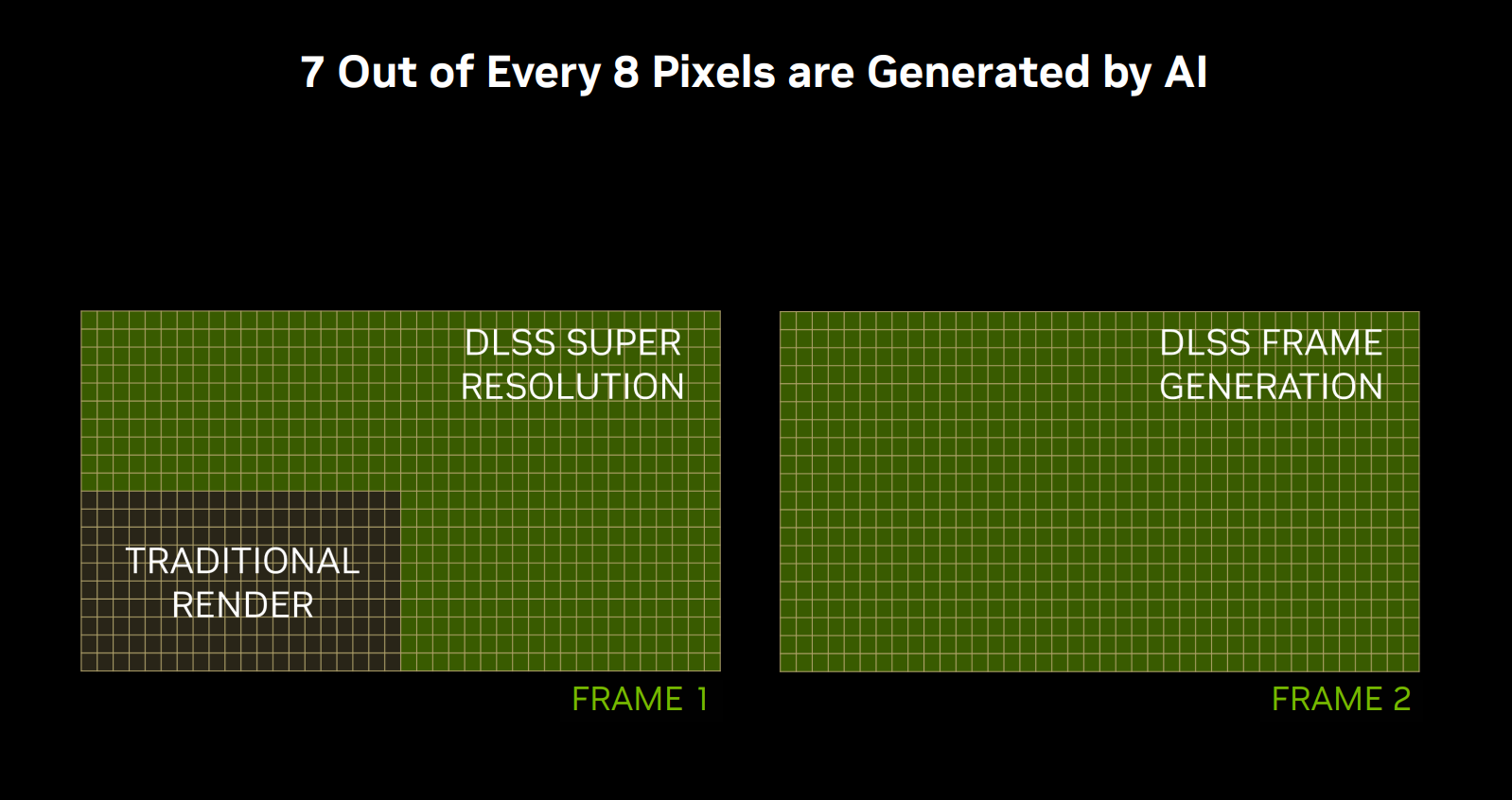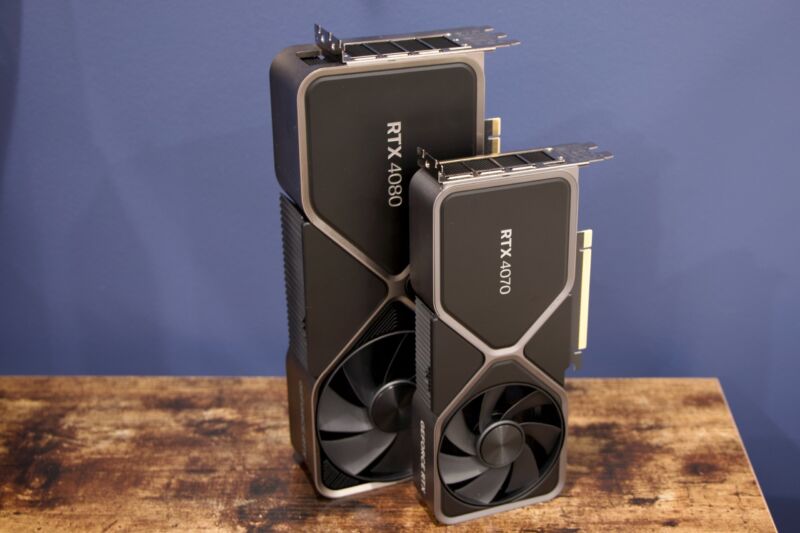Its specs have been thoroughly leaked for anyone paying close attention, but today Nvidia is making it official: It's launching its GeForce RTX 4070 graphics card for a starting price of $599. This GPU will be the cheapest way to buy into Nvidia's Ada Lovelace GPU family, which, in addition to better performance and power efficiency, gets you access to Nvidia's DLSS 3 upscaling and frame-generation features and hardware acceleration for AV1 video encoding. Cards will be available from Nvidia and other partners starting on April 13th.
Nvidia's Founders Edition card is significantly smaller than its RTX 4090 and 4080 GPUs, with a relatively svelte dual-slot cooler that will easily fit into most PC cases. GPUs made by Nvidia's partners can (and will) be more expensive and physically larger, and some of them will also come with 8-pin PCI Express power connectors rather than the newer but somewhat controversial 12VHPWR power connector that Nvidia uses.
The RTX 4070 is $100 more expensive than the $499 starting price of the RTX 3070 and RTX 2070, which were $120 more expensive than the $379 starting price of the GTX 1070. Even accounting for inflation since 2016 ($379 in 2016 is roughly $475 now), it continues a tradition of bumping up the price for GPUs with the same relative position in Nvidia's lineup, something Nvidia partially (and not untruthfully) justifies by pointing out how much faster its modern graphics cards are.
What does $599 get you?
| RTX 4090 | RTX 4080 | RTX 4070 Ti | RTX 4070 | RTX 3080 Ti | RTX 3080 10GB | RTX 3070 Ti | RTX 3070 | RTX 3060 | |
|---|---|---|---|---|---|---|---|---|---|
| CUDA Cores | 16,384 | 9,728 | 7,680 | 5,888 | 10,240 | 8,704 | 6,144 | 5,888 | 3,584 |
| Boost Clock | 2,520 MHz | 2,505 MHz | 2,610 MHz | 2,475 MHz | 1,665 MHz | 1,710 MHz | 1,765 MHz | 1,725 MHz | 1,777 MHz |
| Memory Bus Width | 384-bit | 256-bit | 192-bit | 192-bit | 384-bit | 320-bit | 256-bit | 256-bit | 192-bit |
| Memory Clock | 1,313 MHz | 1,400 MHz | 1,313 MHz | 1,313 MHz | 1,188 MHz | 1,188 MHz | 1,188 MHz | 1,750 MHz | 1,875 MHz |
| Memory size | 24GB GDDR6X | 16GB GDDR6X | 12GB GDDR6X | 12GB GDDR6X | 12GB GDDR6X | 10GB GDDR6X | 8GB GDDR6X | 8GB GDDR6 | 12GB GDDR6 |
| TGP | 450 W | 320 W | 285 W | 200 W | 350 W | 320 W | 290 W | 220 W | 170 W |
The RTX 4070 shares a lot in common with the 4070 Ti, the GPU originally announced as the "RTX 4080 12GB" before being "unlaunched" and relaunched. They share the same AD104 GPU die, a smaller chip than the AD102 flagship used in the RTX 4090 or the AD103 used in the 4080 series. They also both use 12GB of GDDR6X memory on a 192-bit interface. The 4070 has fewer CUDA cores (5,888, down from 7,680), but the 4070 and 4070 Ti are a whole lot more similar than the 16GB and 12GB RTX 4080 cards would have been.
That 192-bit memory interface is narrower than the 256-bit interface used by the 3070 and 3070 Ti, which Nvidia has compensated for by adding 32MB of extra L2 cache to the 4070 (for a total of 36MB). That cache, plus much faster base and boost clock speeds, are the 4070's biggest improvements over the last-gen cards.
There's a lot to recommend the 4070 on paper. It's the first Ada Lovelace graphics card to launch for closer to $500 than $1,000, it's the cheapest way to buy into RTX 4000-series features, and it's at least possible to buy versions that will physically fit inside smaller computer cases. It also promises to be significantly more power-efficient than the 3070 and 3080-series cards it's replacing (and competing with, given how widely available new 3000-series GPUs still are).
But in terms of raw rasterized game performance, it doesn't look like quite as big a slam dunk as the 3070 did when it was released. That GPU could soundly beat the more-expensive previous-generation RTX 2080 and 2080 Super for less money while trading blows with the RTX 2080 Ti. Nvidia's performance numbers for the 4070 show it beating a 3070 Ti and either narrowly beating or narrowly losing to the 10GB version of the RTX 3080. That's not bad, especially if you can actually buy a 4070 for $599—the 10GB 3080 launched for $699, and it still sells for at least that much unless you're buying used or refurbished—but previous midrange GeForce cards have done a slightly better job of bringing last-generation flagship performance down to more reasonably priced PCs.

Nvidia is leaning on DLSS 3 and its AI-accelerated frame generation to make those numbers more impressive. This feature, you might recall from our RTX 4090 review, "doubles" your frame rate by creating one AI-interpolated frame for every frame that the GPU renders. DLSS FG works in concert with the typical "super resolution" upscaling feature that adds pixels to the image your GPU is rendering to make it look more detailed. The result can be a clean-looking, high-resolution, high-frame rate image rendered using just a fraction of the GPU performance that would be needed to render the same scene natively. Nvidia claims the RTX 4070 can be 1.4 times as fast as an RTX 3080 when DLSS FG is enabled.
But as we found in our RTX 4090 review, it tends to work best when your GPU is already pumping out reasonable frame rates, making imperfections in the AI-generated frames harder to perceive. In other words, it's a lot better at making a 60 fps image look like a 120 fps image than it is at making a 15 fps image look like a 30 fps image. DLSS FG can also add latency, making it harder to recommend for twitchy competitive first-person shooters, and it's compatible with a relatively narrow selection of games (though Nvidia's list of "50-plus titles" includes big names like Microsoft Flight Simulator, Diablo IV, and Cyberpunk 2077).
On AMD's end, we're still waiting for the RX 7000 series and the RDNA3 architecture to trickle down to cheaper GPUs, so AMD is fighting this battle with last-gen cards. A recent email from AMD, likely sent in anticipation of the 4070's release, played up the $579 and $649 MSRPs of the Radeon RX 6800 XT and 6950 XT. If you can't find a 4070 in stock for $599—and if you don't mind the lack of DLSS support and inferior ray-tracing performance—either is a plausible alternative to the 4070 for high-end 1440p to low-end 4K gaming.
We'll take a closer look at the RTX 4070 in a full review soon.



3175x175(CURRENT).thumb.jpg.b05acc060982b36f5891ba728e6d953c.jpg)

Recommended Comments
There are no comments to display.
Join the conversation
You can post now and register later. If you have an account, sign in now to post with your account.
Note: Your post will require moderator approval before it will be visible.